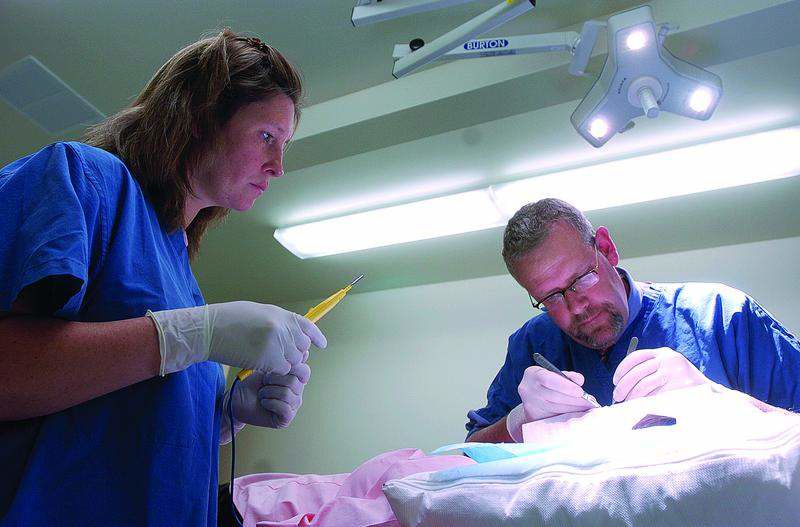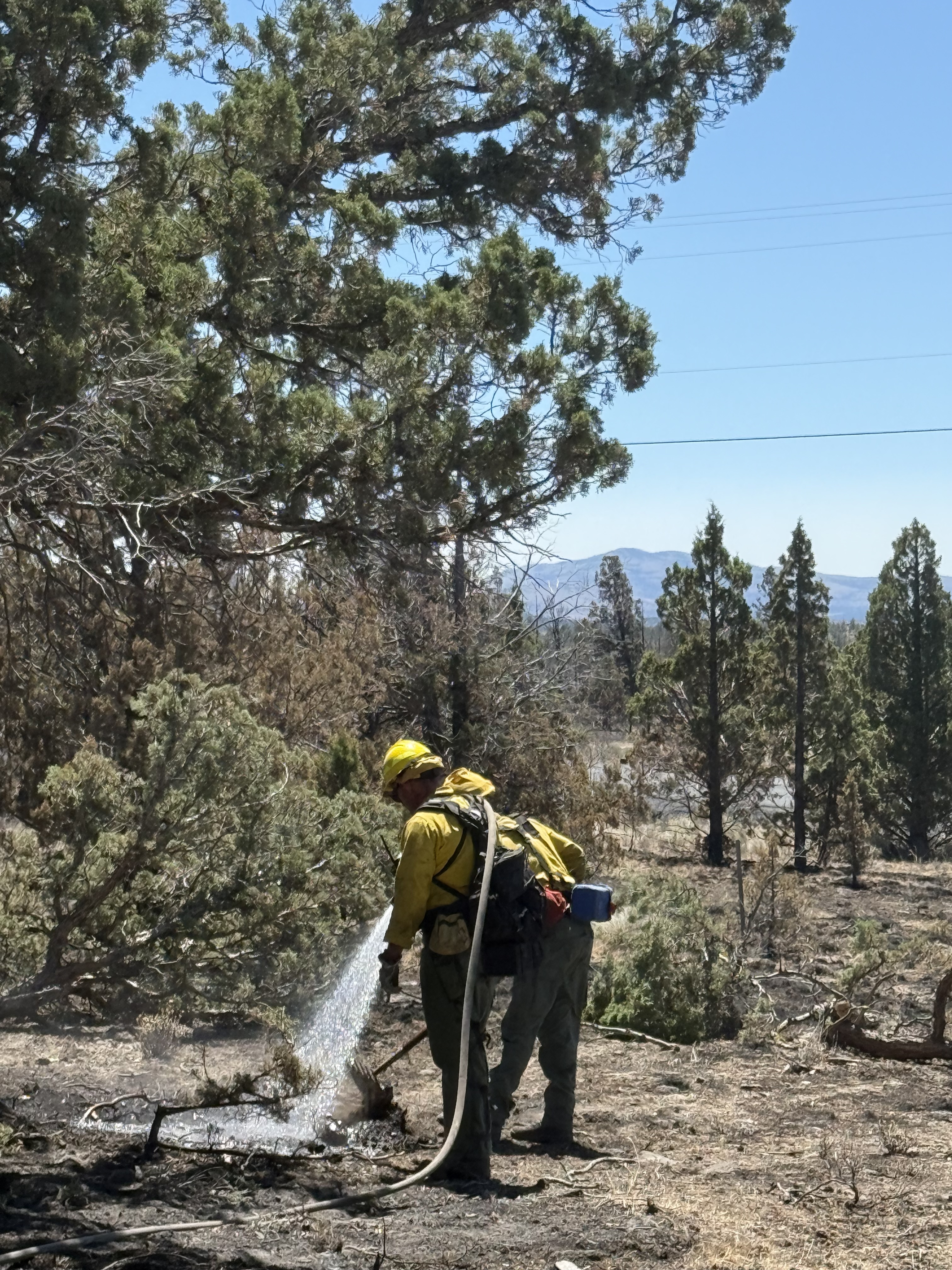Bend goes under the knife
Published 5:00 am Sunday, September 17, 2006

- Dr. Robert Quinn, a plastic surgeon, and his assistant Corene Follett, left, remove a lesion from a patient's face in Quinn's Bend office. Quinn is one of nine plastic surgeons in Central Oregon who say local patients are keeping them busy.
Stop by one of Bend’s two dozen coffee shops at midday and you’ll probably find a handful of post-workout runners checking their e-mail and sipping iced mochas. The city has become such a destination for active, outdoorsy folks that the slender, the muscled and the suntanned are as much a part of Central Oregon’s scenery as the Three Sisters.
But even in Bend, natural beauty sometimes has to be trimmed, plumped or buttressed. The city is home to seven full-time plastic surgeons who say business has never been better. Two local practices hired additional doctors in the last year. And cosmetic surgeries here are often booked six months in advance.
Trending
About 24 cosmetic operations are performed in Bend each week. Details surrounding these surgeries provide unique, intimate insights.
Big numbers
Bend has four plastic surgeons who are board certified, or have passed a rigorous series of exams and requirements – Dr. Gary Gallagher, Dr. Linda Leffel, Dr. Robert Quinn and Dr. Michael Villano. One local plastic surgeon – Dr. Adam Angeles – is board eligible, which means he is in the process of being certified.
Two other plastic surgeons practice full time in Bend without that extra credential – Dr. Paul Van Camp and Dr. Daniel Teng.
At least one oral and facial surgeon in Bend, Dr. Todd Schock, practices some plastic surgery. And one plastic surgeon from outside the area – Dr. Mark Warner – holds occasional office hours in Redmond. Several plastic surgeons in other parts of Oregon also advertise in Bend.
In short, there’s no shortage of plastic surgeons.
Trending
The American Society of Plastic Surgeons presents this rule of thumb to members thinking about opening a new practice: A typical market supports one plastic surgeon for every 40,000 to 50,000 residents. Bend, in other words, has enough plastic surgeons to theoretically support a population of about 350,000 people.
Plastic surgery involves cosmetic surgery as well as reconstructive surgery.
Van Camp and Teng practice cosmetic surgery exclusively. Leffel, Gallagher, Quinn and Villano said they primarily do cosmetic surgery.
Angeles said his work is split evenly between the two. His reconstructive work tends to focus on burn patients.
”You’d be surprised by how many burn patients we see, even in a place like Bend,” he said.
Children fall against the fireplace screen and burn their hands or food service workers get splattered with hot oil, he said.
Other reconstructive surgeries include breast reconstructions for mastectomy patients, and facial reconstructions for oral or skin cancer patients.
Plastic surgeons say it’s easy to find steady work doing reconstructive work, which is usually covered by insurance companies. But elective plastic surgery, which is not covered by insurance, tends to be more lucrative for doctors. As their practices mature, surgeons shift their focus to cosmetic patients.
Six of the seven full-time plastic surgeons in Bend provided to The Bulletin the numbers of certain cosmetic procedures they performed in the last year, excluding non-surgical acts like Botox injections and skin resurfacing.
Those procedures are sometimes also performed by dermatologists – of which Bend has nine. Bend also has four vein treatment centers, which perform many cosmetic procedures.
The most common cosmetic surgery in Bend last year was liposuction, with 294 procedures performed. Liposuction is used to sculpt the body by vacuuming fat out of a specific area like the neck or hips. It was also the most popular cosmetic surgery nationwide in 2005, with 323,605 patients receiving the procedure.
Bend’s second most popular procedure was breast augmentation, with 276 performed in the last year. Breast augmentation was the third most popular procedure nationwide in 2005, with 291,350 operations performed.
Breast implants aren’t usually obvious looking here, doctors said.
”Women here are looking for a natural appearance,” said Leffel.
They want smaller breasts than women in urban centers generally want, she added.
That’s likely due to the active Bend lifestyle, which is also one reason that breast reduction was the third most popular procedure in Bend last year.
”I see a lot of post-pregnancy women who are trying to get their bodies back in shape,” Leffel said.
Those patients frequently seek breast lifts, breast augmentation, tummy tucks and liposuction.
Regional trend
Central Oregonians had relatively few nose jobs when compared to the rest of the country. Rhinoplasty, or nose reshaping, was the second most popular cosmetic procedure in the U.S. in 2005, according to the American Society of Plastic Surgeons. Nearly 300,000 nose jobs were performed in the U.S. last year, but only 51 in Bend.
Nose jobs are most common in ethnically diverse parts of the country, said Villano, whose plastic surgery practice focuses on facial surgeries.
”You see more Italians, Jewish people, Middle Eastern people, getting rhinoplasty,” Villano said.
Surgeons notice other sweeping commonalities among local patients.
”One hundred percent of my patients are outdoorsy, athletic people,” said Van Camp, whose practice focuses on liposuction and laser resurfacing. ”There’s a very high level of overall fitness here. Interestingly enough, though, there’s a lot of body consciousness here, too.”
Personal trainers, yoga instructors, dance teachers and triathletes have all come to Van Camp for liposuction, he said.
The doctor theorizes that Bend’s culture of fitness creates social pressures to look young and trim. When diet and exercise can’t do the job, people turn to plastic surgery.
Dr. Mark Jewell is a cosmetic surgeon in Eugene who regularly sees patients from east of the Cascades.
”They have reasonable expectations; they are looking for improvement but not perfection,” he said of Central Oregonians. ”And they are, if anything, fitter than other patients I see from the rest of the state.”
Central Oregonians also have a lot of sun damaged skin, he said.
According to Gallagher, Bend residents want to come out of plastic surgery looking natural, not overdone.
”Bend is basically a conservative place. They want to look natural, they don’t want to look like they’ve obviously had plastic surgery. In other parts of the country, that’s not the case,” he said.
Gallagher described the Bend style as ”wash and wear” – in other words, people don’t wear a lot of makeup or spend a lot of time primping each day.
Doctors said patients here are often concerned with how much recovery time a surgery will require. They want to get back on their skis or mountain bikes.
That active lifestyle can actually pose challenges to plastic surgery itself, doctors said.
”We have to deal with a lot of exposure to the elements,” Gallagher said. Sun, wind and cold can be tough on sensitive, post-operative skin.
That’s one reason why chemical peels – which leave skin raw and sensitive for months after the skin-renewing procedure is finished – are not popular here, doctors said. More than 1 million patients got chemical peels in the U.S. last year, according to the American Society of Plastic Surgeons, but only a handful got them in Bend.
A personal decision
Cosmetic surgeons say they work in a unique field of medicine because it is entirely elective. That translates into a different patient-doctor relationship than most people share with their family physician. For one thing, plastic surgeons have to learn why their patients are seeking cosmetic surgery.
”If we operate on someone who wants it for the wrong reasons, that’s bad for everybody,” said Quinn. ”The patient won’t be happy and it could hurt our reputation.”
Women and men tend to give different reasons for seeking plastic surgery, doctors said. Women usually give personal reasons, like low self-esteem. Men usually give external reasons, like workplace pressures and discrimination.
Nationally, about 95 percent of plastic surgery patients are female. Both men and women have been getting more cosmetic surgery in recent years. Doctors say that’s because of improved technology – which can reduce recovery time and enhance results – and a more accepting view of the practice.
Cosmetic surgery is a mainstream fixture with reality shows like ”Extreme Makeover” and fictional shows like ”Nip/Tuck.”
”Talking about surgery now, especially plastic surgery, it’s like saying ‘lunch,’ it’s something people consider to be routine,” said Quinn. ”They see it as just another life experience … . I think it is a little bit underrated in terms of what the risks are.”
Gallagher said a lot of his time is spent managing patients’ expectations. Some expect a surgery will produce unreasonable results. Others expect recovery will be painless and quick.
Less than one half percent of U.S. plastic surgery patients ever encounter serious side effects from plastic surgery, according to trade organizations. But possible risks are severe, including complications from anesthesia like blood clots, stroke or heart attack. Other risks involve nerve damage, scarring, infection and an asymmetrical or dimpled appearance.
”It’s not having your nails done. It’s not having your hair colored. It’s surgery, it’s serious,” Gallagher said. ”There are risks, there are costs.”
Cosmetic surgery is rarely covered by insurance. And costs are often steep.
Breast augmentation surgery cost an average of $4,300 in 2005, according to the American Society for Aesthetic Plastic Surgery. And liposuction cost about $3,000. Americans spent almost $12.5 billion on cosmetic surgery last year.
Still, local surgeons say their patients are not just the very rich. Some are teachers, some are housewives. All of the local surgeons interviewed said the majority of their patients live here in Central Oregon.
”I think there will always be a group of patients who go out of town, more for anonymity than for quality of care,” said Leffel.
As Bend’s population continues to grow, doctors expect the number of plastic surgery patients will grow, too.
Even the changing weather is good for business, as local surgeons gear up for the busiest season of the year.
”In the fall and winter I tend to do bigger operations,” Villano said. ”Because the summer is so short, people don’t want to spend the summer inside, recovering.”








